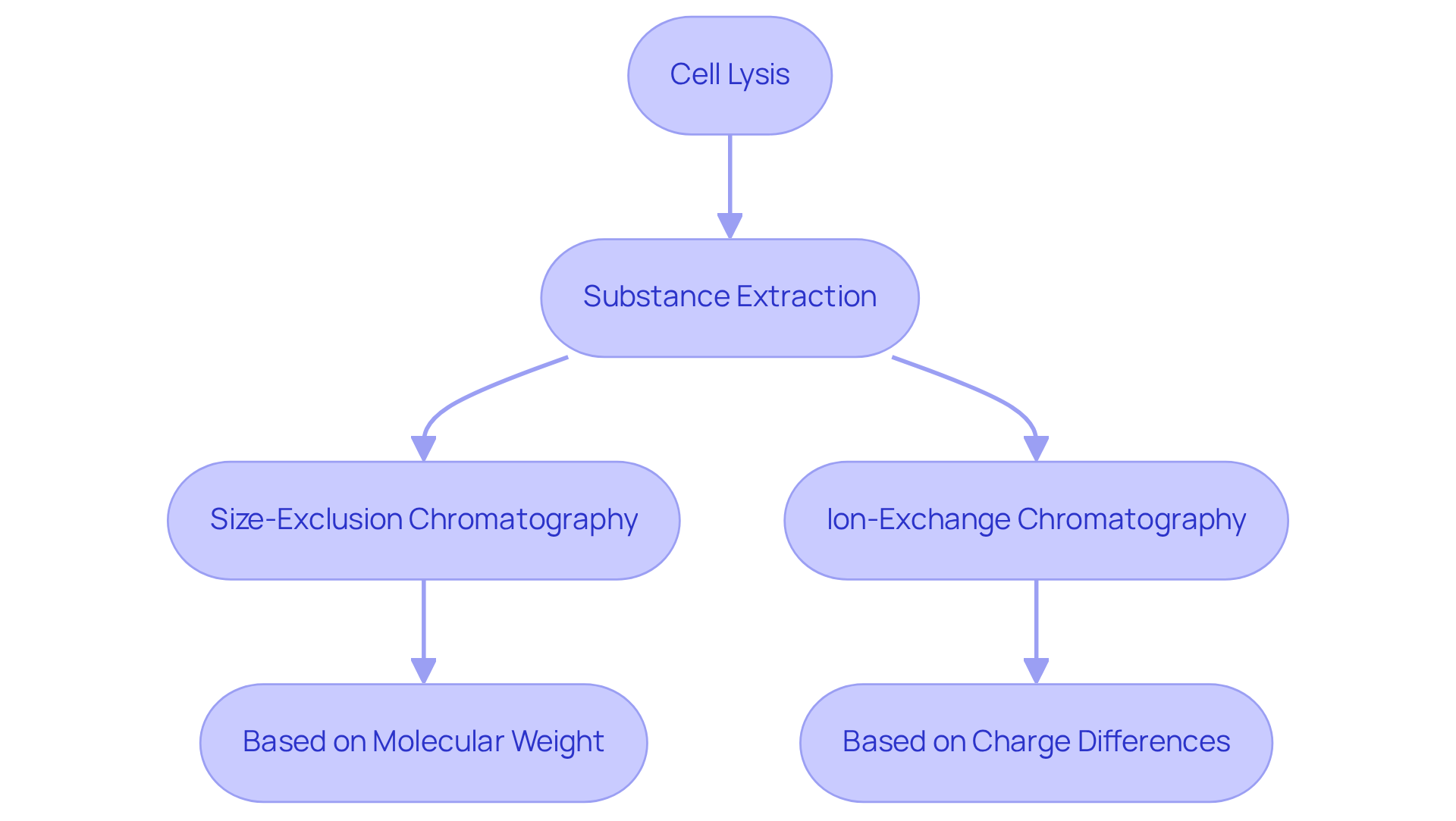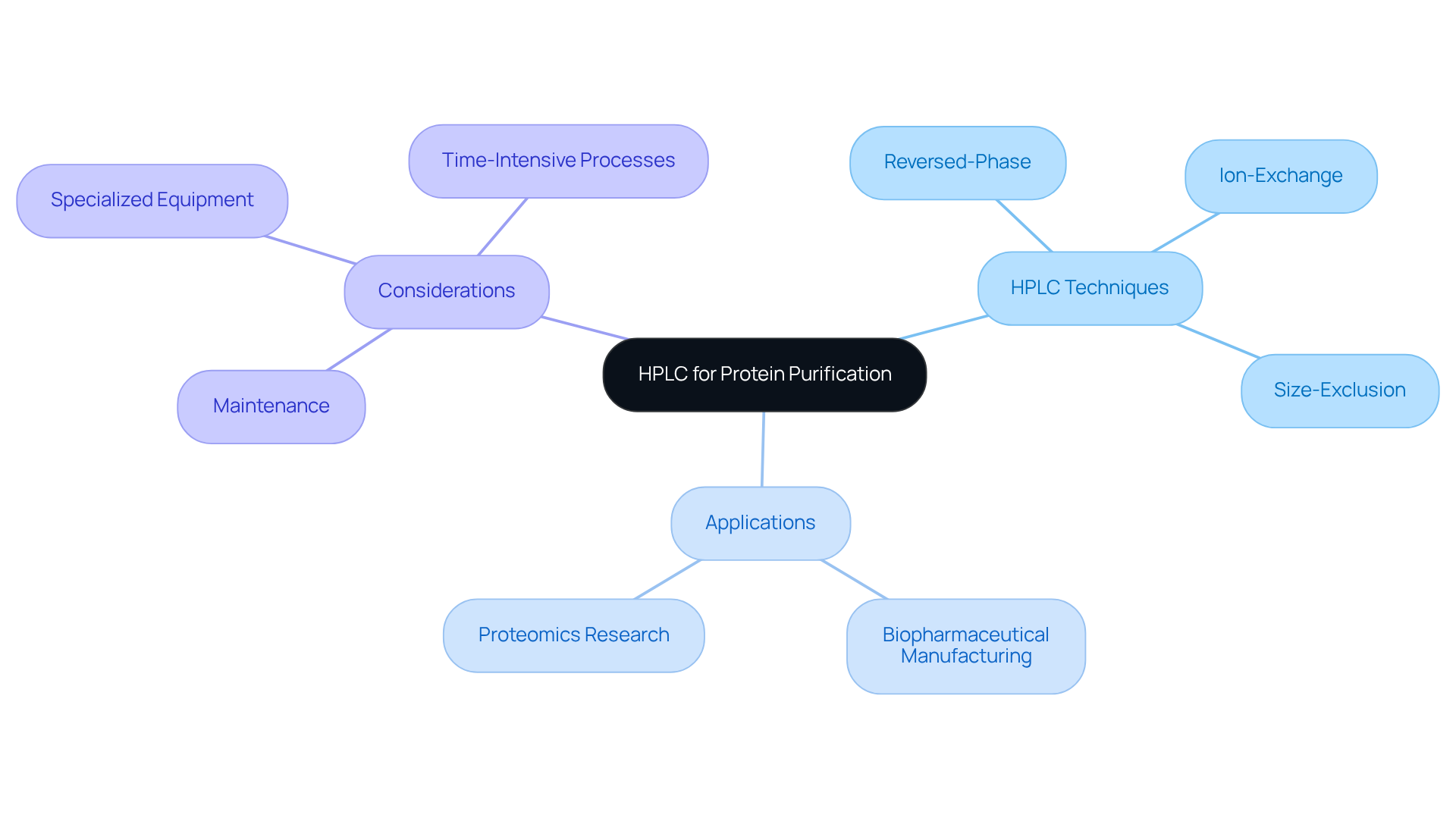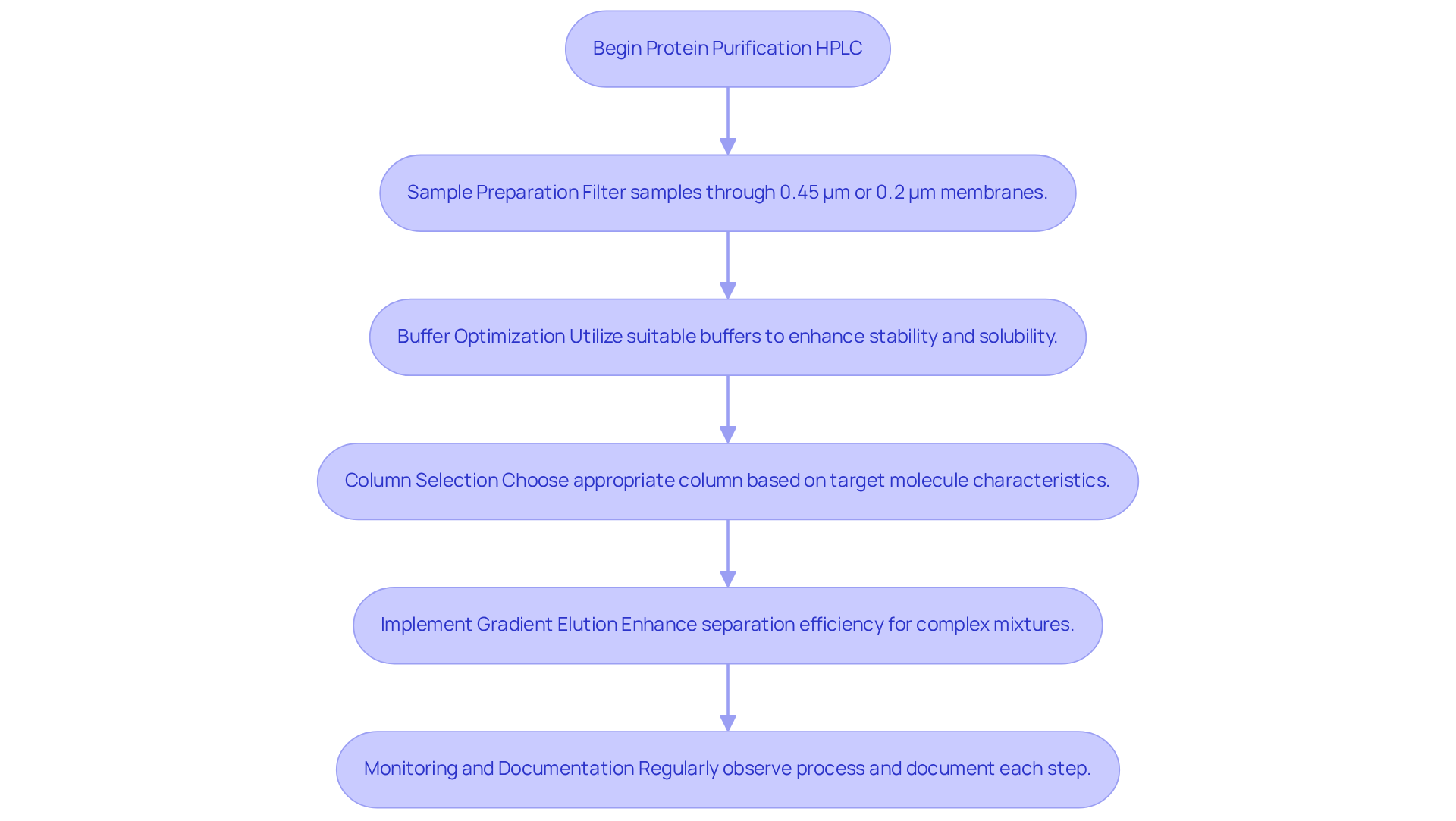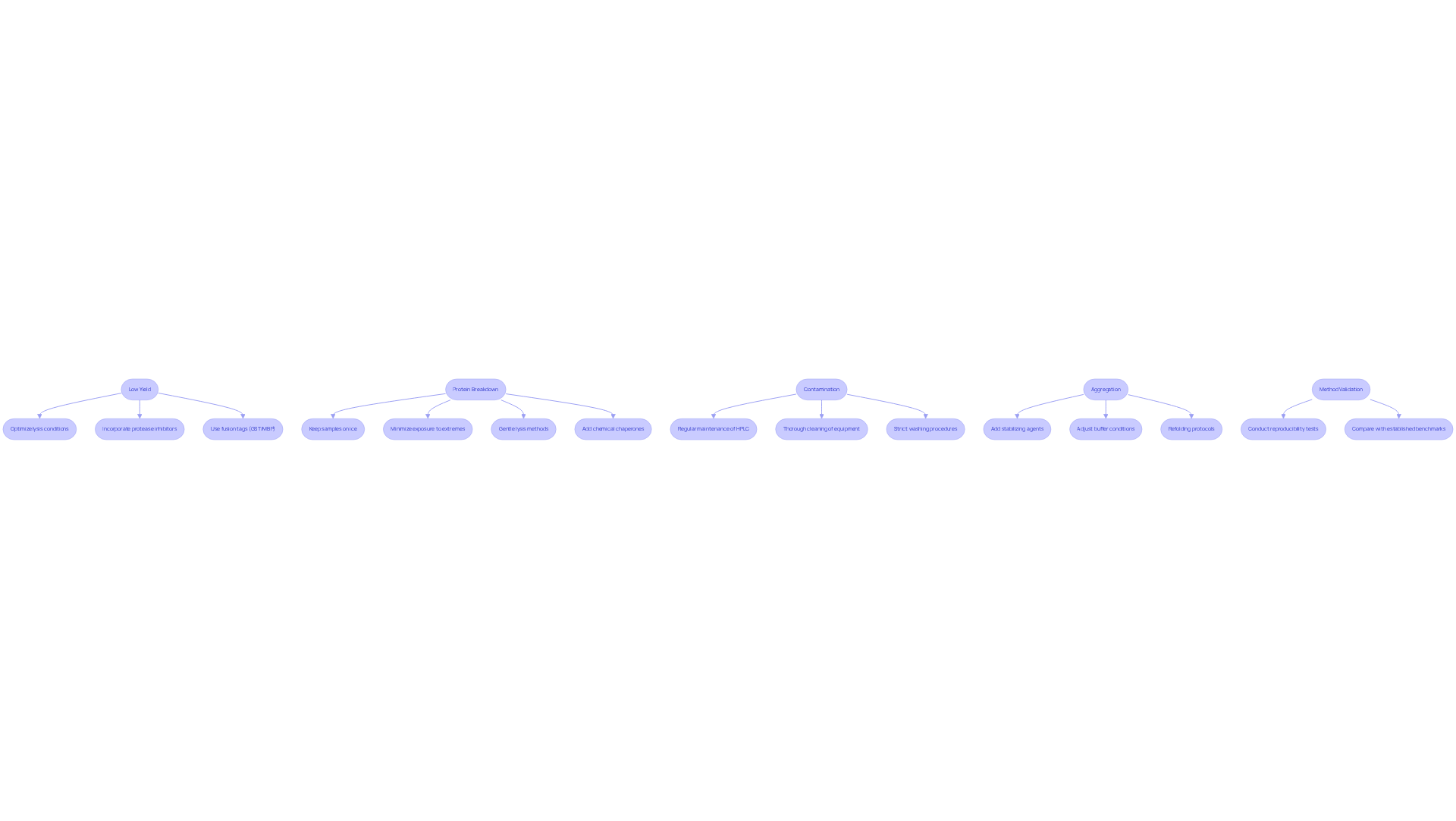Overview
This article delineates four pivotal strategies for achieving success in protein purification through high-performance liquid chromatography (HPLC). It underscores the critical roles of:
- Sample preparation
- Buffer optimization
- Column selection
- Continuous monitoring
throughout the purification process. These strategies are bolstered by expert recommendations and illustrative case studies that exemplify their efficacy in surmounting prevalent challenges, including low yield, protein degradation, and contamination. Ultimately, these approaches significantly enhance both the purity and yield of target proteins, establishing a robust framework for successful protein purification.
Introduction
The quest for purifying proteins stands as a cornerstone of modern biochemistry, crucial for advancing both research and therapeutic applications. As scientists explore the intricacies of biomolecule extraction, high-performance liquid chromatography (HPLC) emerges as an invaluable ally, providing unparalleled resolution and efficiency. Nevertheless, the journey toward successful protein purification is riddled with challenges, ranging from low yields to contamination risks. What strategies can researchers implement to navigate these obstacles and achieve optimal results in their purification endeavors?
Understand Protein Purification Fundamentals
The extraction of specific biomolecules is a fundamental procedure in biochemistry and molecular biology, designed to isolate particular substances from complex mixtures. This process encompasses essential steps, including:
- Cell lysis
- Substance extraction
- Various refinement techniques
Protein purification HPLC is recognized as a primary method. Understanding the characteristics of the target protein—such as size, charge, and hydrophobicity—is vital for selecting the appropriate isolation strategy. For example:
- Size-exclusion chromatography effectively separates biomolecules based on molecular weight.
- Ion-exchange chromatography leverages charge differences for separation.
Grasping these principles enables researchers to tailor their extraction methods, significantly enhancing yield and purity levels of the final products in . Case studies illustrate the successful implementation of these techniques, highlighting the necessity of a customized approach for optimal results. As emphasized by experts, a deep understanding of the properties of these substances is crucial for refining extraction methods and ensuring the integrity of the isolated compounds.

Leverage HPLC for Effective Protein Purification
High-performance liquid chromatography (HPLC) is a premier method for protein purification, effectively isolating biomolecules based on their unique physicochemical characteristics. By employing various HPLC modes—such as reversed-phase, ion-exchange, and size-exclusion techniques—researchers achieve remarkable resolution and purity. For example, reversed-phase HPLC excels in isolating hydrophobic proteins, while ion-exchange chromatography effectively targets proteins with distinct charge characteristics. The significantly enhances their utility, making them suitable for both small-scale research and large-scale industrial applications.
Routine maintenance and adjustments of liquid chromatography systems are crucial to ensure stable performance and reproducibility of results, thereby enhancing the effectiveness of the purification method. Notably, the Global Protein Purification HPLC Market was valued at approximately USD 9,125.8 Million in 2023, with an expected expansion at a CAGR of 9.2% from 2024 to 2033, underscoring the increasing demand for HPLC technologies. The Waters Alliance™ iS Bio High-Performance Liquid Chromatography System exemplifies advancements in liquid chromatography technology, streamlining workflows and minimizing human error.
Case studies further illustrate the successful application of HPLC in various contexts, including its critical role in biopharmaceutical manufacturing and proteomics research, highlighting its efficiency in methods for protein purification HPLC. However, it is essential to consider potential drawbacks of HPLC, such as the time-intensive nature of certain processes and the need for specialized equipment. These factors are vital considerations for lab supervisors when evaluating separation techniques.

Implement Expert-Recommended Best Practices
To achieve success in protein purification HPLC, it is essential to adhere to several best practices that ensure optimal outcomes.
- Sample Preparation: Begin with meticulous sample preparation. Properly filter all samples through membranes of 0.45 µm or 0.2 µm to eliminate particulates that could obstruct the HPLC column.
- Buffer Optimization: Next, focus on buffer optimization. Utilize that not only preserve the stability of the target molecule but also enhance its solubility. Adjusting pH and ionic strength is crucial, as these factors can significantly influence the behavior of biomolecules during purification.
- Column Selection: The choice of column is paramount. Select the appropriate column based on the characteristics of the target molecule. For instance, employing a C4 column for hydrophobic substances can lead to markedly improved results.
Implementing gradient elution techniques in protein purification HPLC can enhance separation efficiency, particularly for complex mixtures. This method facilitates improved resolution of closely related molecules, which is vital for successful purification.
- Monitoring and Documentation: Finally, prioritize monitoring and documentation throughout the refinement process. Regularly observe the process using analytical techniques such as SDS-PAGE or mass spectrometry to assess purity and yield. Careful documentation of each step not only aids in troubleshooting but also optimizes future runs, reinforcing the importance of thoroughness in scientific practice.

Overcome Challenges in Protein Purification
Purification of these substances often encounters significant challenges, such as low yield, degradation, and contamination. Addressing these issues is crucial for achieving optimal results in protein purification HPLC.
- Low Yield: To enhance yields, it is essential to optimize lysis conditions and incorporate protease inhibitors to prevent degradation during extraction. Employing methods such as fusion tags like GST or MBP, as illustrated in case studies focused on enhancing solubility, can significantly boost both solubility and yield.
- Protein Breakdown: Preserving the integrity of the substance requires keeping samples on ice and minimizing exposure to extreme conditions. Utilizing gentle lysis methods and incorporating additives like is vital for maintaining the structural integrity of these molecules.
- Contamination: Regular maintenance and thorough cleaning of HPLC equipment are imperative to prevent cross-contamination. Implementing strict washing procedures between runs effectively reduces contamination risks, particularly concerning the co-purification of undesired host substances and nucleic acids.
- Aggregation: In instances where substances aggregate during isolation, consider adding stabilizing agents or adjusting buffer conditions to enhance solubility. Refolding protocols, as highlighted in typical extraction challenges, can also be beneficial in solubilizing substances from inclusion bodies.
- Method Validation: To ensure the reliability and consistency of extraction methods, conducting reproducibility tests and comparing results with established benchmarks is crucial. This validation process is essential for achieving high-quality outcomes in protein purification HPLC.

Conclusion
Successful protein purification using high-performance liquid chromatography (HPLC) is fundamentally dependent on a comprehensive grasp of both its underlying principles and the practical strategies essential for effective execution. The capacity to isolate specific biomolecules from intricate mixtures is pivotal in propelling research and applications within biochemistry and molecular biology. By mastering the characteristics of target proteins and employing customized purification techniques, researchers can significantly improve both yield and purity.
Key strategies, including meticulous sample preparation, buffer optimization, and careful column selection, are indispensable for achieving optimal outcomes in protein purification. Furthermore, the implementation of expert-recommended best practices—such as gradient elution and thorough monitoring—can effectively mitigate common challenges, including low yield and contamination. By proactively addressing these issues with well-founded solutions, researchers can refine their methodologies and enhance the reliability of their results.
The growing demand for efficient protein purification methods highlights the critical role of HPLC in both academic research and industrial applications. As the discipline continues to advance, adopting these strategies and best practices will not only elevate the quality of protein purification but also contribute to significant progress across various scientific fields. It is crucial for researchers to remain abreast of the latest techniques and challenges in protein purification to ensure sustained success in their endeavors.




